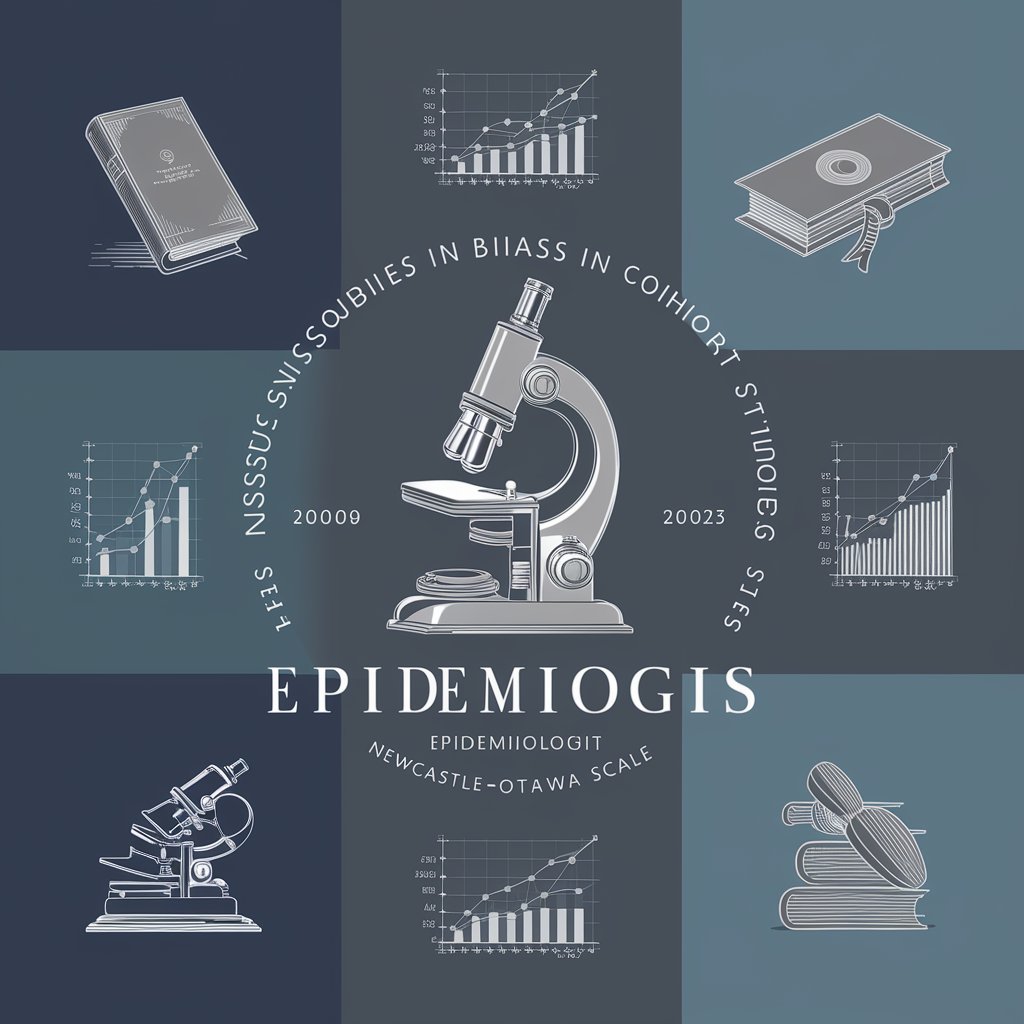Cohort study risk of bias (NOS) - cohort study bias evaluation

Welcome to your cohort study bias assessment expert.
AI-driven bias assessment for cohort studies
Analyze the cohort study for risk of bias using the Newcastle-Ottawa Scale...
Evaluate the selection criteria of the cohort study...
Assess the comparability of the cohorts based on the design or analysis...
Determine the adequacy of the follow-up period for the outcomes of interest...
Get Embed Code
Overview of Cohort Study Risk of Bias (NOS)
The Cohort Study Risk of Bias tool, based on the Newcastle-Ottawa Scale (NOS), is designed to evaluate the quality and potential bias in cohort studies. This assessment tool helps to identify strengths and weaknesses within the design and execution of cohort studies by examining three core areas: Selection, Comparability, and Outcome. Each area includes specific criteria that are scored to reflect the risk of bias in the study. For example, the Selection category assesses how representative the exposed and non-exposed cohorts are within the community, how exposure was ascertained, and whether the outcome of interest was present at the start of the study. Powered by ChatGPT-4o。

Key Functions of Cohort Study Risk of Bias (NOS)
Bias Evaluation
Example
Evaluating whether a cohort study's selection of participants introduces bias by analyzing the representativeness of the exposed cohort. For instance, a study on the impact of smoking on lung health might be evaluated on whether participants were representative of the general population or just a specific group, like nurses.
Scenario
Researchers assessing the validity of findings from a published cohort study on dietary impacts on heart disease.
Comparison Standardization
Example
Assessing the comparability of cohorts based on design or analysis adjustments, such as controlling for age and gender in a study comparing the health outcomes of two different diet groups.
Scenario
A health policy analyst comparing two studies to determine the more reliable study for forming dietary guidelines.
Outcome Assessment
Example
Determining the method of outcome assessment in cohort studies, such as identifying if outcomes like mortality were assessed through independent blind assessment or through record linkage.
Scenario
A clinical researcher determining the reliability of a study’s findings on the effectiveness of a new cancer treatment.
Ideal Users of Cohort Study Risk of Bias (NOS) Services
Researchers and Academics
This group benefits from using NOS to critically evaluate the quality and bias in observational studies, which is crucial for incorporating study findings into scientific reviews or further research.
Health Policy Analysts
Analysts use NOS to determine the reliability of studies that inform policy decisions, ensuring that health policies are based on robust and unbiased scientific evidence.
Clinical Guidelines Committees
Committees rely on the NOS to assess the validity of studies that are being considered as the basis for clinical practice guidelines, ensuring that recommendations are grounded in high-quality research.

Using Cohort Study Risk of Bias (NOS)
Step 1
Visit yeschat.ai to access a free trial without the need for a login or a ChatGPT Plus subscription.
Step 2
Familiarize yourself with the Newcastle-Ottawa Scale (NOS) by reviewing its guidelines to understand how to assess the quality of cohort studies.
Step 3
Prepare the cohort study documents you need to evaluate, ensuring you have complete access to all necessary details to perform a thorough analysis.
Step 4
Apply the NOS criteria systematically to each study, assigning stars based on the selection, comparability, and outcome measures to determine the risk of bias.
Step 5
Use the results from the NOS evaluation to guide research decisions, enhance study designs, or develop further hypotheses.
Try other advanced and practical GPTs
Android Development Coach
AI-Powered Assistant for Android Developers

Esperto di Patologia e Biochimica
Decoding Pathology with AI

Resumen de Artículos
AI-Powered Summaries and Analysis.

Resumen de PDF
Streamline your understanding with AI

ESCRITA - Análise e Melhoria
AI-Powered Text Enhancement

Escritor Acadêmico APA
Empowering Academic Excellence with AI

Descripcion MERCADO LIBRE
Enhance Listings with AI-Powered Descriptions

Profesor Derecho Laboral Español
Master Spanish Employment Law with AI

Plan de Marketing Digital
Your AI-Powered Marketing Strategist

Second Brain Prompt Engineer
Power Your Creativity with AI

Néstor S.O.S. (Situaciones aprendizaje LOMLOE)
Empowering Educators with AI

Mecanic
Revolutionizing vehicle troubleshooting with AI

Q&A about Cohort Study Risk of Bias (NOS)
What is the purpose of the Newcastle-Ottawa Scale?
The Newcastle-Ottawa Scale (NOS) is designed to assess the quality and risk of bias in observational studies, specifically cohort and case-control studies. It evaluates studies based on selection, comparability, and outcome of the study groups.
How do you assign stars in the NOS?
Stars are assigned based on specific criteria within three broad categories: Selection, Comparability, and Outcome. Each category has detailed criteria that a study must meet to earn stars, indicative of higher quality and lower bias.
Can NOS be used for systematic reviews?
Yes, NOS is commonly used in systematic reviews to assess the quality of included cohort studies, providing a standardized method to gauge study reliability and guide conclusions.
What does a 'no star' rating mean in the NOS evaluation?
A 'no star' rating typically indicates that the study did not meet the criteria for quality in the specific NOS category being evaluated. This could suggest a higher risk of bias in those aspects of the study.
Is the NOS applicable only to medical research?
While NOS is primarily used in medical and health sciences research to evaluate observational studies, the principles of quality assessment can be adapted for use in other scientific disciplines that utilize observational research methods.
